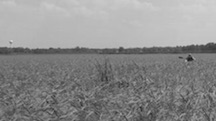
By Mille Lacs Band of Ojibwe, October 2, 2015
*from the Mille Lacs Lake Watershed Management Group
by Perry Bunting, Mille Lacs Band DNR*
Wild rice (or “manoomin”) is an important cultural food of the Ojibwe People, a critical food source for waterfowl, a habitat for species ranging from deer to snails, and a haven for furbearing animals like muskrat and beaver. The benefits wild rice provides to our lakes and the beings that rely on these lakes are endless.
Project background
Lake Ogechie is a shallow, 405-acre enlargement of the Rum River immediately downstream from Lake Mille Lacs. Lake Ogechie once supported dense and vigorous stands of wild rice, serving both as a source of sustenance and as a gathering place for many Native Americans at camps along its shores. Over time, several factors may have contributed to the ecological decline of Lake Ogechie. Construction of logging dams in the mid to late 1800s on the Rum River was common. The first known dam constructed near the outlet of Ogechie in 1934 resulted in a permanent change in water levels. It is believed the dam’s purpose was to restore wild rice stands and enhance Ogechie for waterfowl, although anecdotal information suggests the opposite occurred. The dam was substantially reconstructed in 1952 and currently controls water levels within Lake Mille Lacs and Ogechie.
Extensive study has indicated that the demise of wild rice on Lake Ogechie is primarily a result of high water levels and excessively stable water levels. While the resultant effects have essentially destroyed wild rice on Lake Ogechie, what is more difficult to assess is the damage to wildlife, waterfowl and the fisheries that use this ecosystem. The main step in wild rice restoration is the lowering of lake levels through the modification of Buckmore Dam.
The Mille Lacs Band Department of Natural Resources/Environment (DNRE) approached the Minnesota Department of Natural Resources (MnDNR) to consider a partnership to evaluate the feasibility of restoring wild rice in Lake Ogechie. This partnership is critical because Lake Ogechie is within Kathio State Park and the Mille Lacs Band currently shares land and resource management responsibilities with tribal trust lands along Ogechie’s shores. In addition, Lake Ogechie is within the 1837 Ceded Territory and within the exterior boundaries of the 1855 Mille Lacs Reservation. The Secretary of the Interior has also determined the Kathio Landmark to be significant to the history of the United States of America.
Purpose
The overall project purpose is to restore a naturally reproducing, vigorous and genetically unmodified wild rice stand within an ecologically “balanced” Lake Ogechie, while not adversely impacting the post Buckmore Dam era water levels of Lake Mille Lacs and other downstream lakes within the Upper Rum River system. Because of the success of a similar restoration project on Lake Onamia (see photo below), the Mille Lacs Band DNRE recognized the opportunity and need to restore wild rice production on Lake Ogechie.
It is critical that water depths are maintained within a desired range of 1 to 3 feet during the wild rice growing season. Based on the modeling, the concept capable of attaining the design criteria and therefore considered feasible is achieved by reconstructing a new fish passage/water control structure at the headwaters of the Rum River and removing three feet from the existing Buckmore Dam.
The first phase of this project is now complete with the recent construction of a fixed-crest weir at the outlet of Mille Lacs Lake. This new structure replicates the current flow from Mille Lacs Lake into Lake Ogechie while maintaining existing water levels within Mille Lacs Lake. Phase II of this project necessitates modification of Buckmore Dam at the outlet of Lake Ogechie. This modification will remove the top three feet of the dam, lowering the run out from an elevation of 1250.5 to 1247.5. The timeline for Buckmore Dam modification is October of 2015.
Summary
The ecological benefits of a restored Lake Ogechie are numerous. The modification of Buckmore Dam is expected to result in a hydrologic regime and physical conditions necessary for a sustainable ecosystem characterized by a viable, vigorous, and self-reproducing wild rice stand. This portion of the Upper Rum River is expected to serve as an important waterfowl, feeding, resting and staging area with the resurgence of wild rice. With the modifications of Buckmore Dam, fish passage will be restored and a safety hazard eliminated. This project also promotes a partnership between the BIA, Mille Lacs Band of Ojibwe and the MnDNR to achieve consistent conservation goals and demonstration of trust responsibility to tribes.